Allocation Methodology of Process-Level Carbon Footprint Calculation in Textile and Apparel Products
Abstract
1. Introduction
2. Literature Review
2.1. Avoiding Allocation
- The Subdivision Method. Multiple products are divided into multiple subprocesses that belong to each product, and then the input and output data for each subprocess are collected. The subdivision method has higher requirements on the quality of data. It generally requires companies to install energy consumption meters in order to obtain real-time data, which is difficult to achieve in textile industry.
- The System Expansion Method. Finding alternative production processes that are equivalent to target production process. The alternative production process here is a production process with the same kind and quantity of products as target product. Maarten et al. [17] used this method in the case of power generation and used natural gas power generation as an alternative process for coke oven gas power generation. However, this method has limitations. On the one hand, the alternative production process is more difficult to find. On the other hand, the alternative production process has a different CF compared to the aiming production process. Thus, the accuracy of the accounting results will be affected.
2.2. Allocation Method
- Physical relationship between products: allocation according to the physical relationship between products. The most common physical parameter is mass.
- Mass or volume of the product: the overall CF should be allocated according to the mass or volume. In the production system, the larger quantity product has generally larger CF. But this method is based on the premise that the CF in unit quantity of different products is equal. In fact, due to the difference in product properties, the energy consumption and material consumption of different products are different. This method is not suitable for large carbon emissions where there is only energy output without mass output, for example, the allocation of electricity and heat.
- Energy value: This method is applicable to the accounting of CF generated by fossil fuels and steam consumed in production. However, to the best of our knowledge, this method has not been used for apparel industry. This method is used in the example of Maarten et al. (2013) for waste generation, and the carbon emission of two processes of raw iron production and electricity production is allocated by the energy proportion of C converted into CO and CO converted to CO2 in the energy of C converted into CO2. This method also has its limitations. In this case, it is assumed that in the production of raw iron, C is converted only into CO. But, most of the C during real production is converted into CO2 directly.
- The other allocation method is used when the physical relationships between the products cannot be clarified. The economic relationship between the products is often used as the indicator [29]. However, this allocation method has its limitations. The method is a hypothesis that the higher price value of the product, more energy will be consumed. The economic value is a comprehensive indicator that reflects the combination of production cost, brand value, market value. Besides, economic allocation method is in some ways more problematic due to the temporal and geographical variability [30]. Therefore, an economic relationship cannot directly reflect the environmental burdens relationship between the products.
3. Allocation methodology
3.1. CF Data Construction and Allocation Technical Framework
- Developed a process-level flow chart. The chart shows major refining processes that are interconnected by energy and material streams. The study incorporated an appropriate level of detail, which was prepared as part of a comprehensive energy and materials flow analysis and is available without violating confidentiality of information for a given factory.
- Splitting the total CF data into different products by products allocation method (Equation (2) or (3)).
- Under a certain product, splitting the CF data of individual product into three sections by sections allocation method (Equation (4), Equation (5), Equation (6)).
- Splitting the CF data of S1 into CFU by sections allocation method. Splitting the CF data of S2 into CFU by auxiliary allocation method (Equation (7)). Splitting the CF data of S3 into CFU equally.
- CF of individual product can be formalized mathematically by Equation (1).
3.2. Products Allocation Method
3.3. Sections Allocation Method
3.4. Auxiliary Allocation Method
4. A Case Study: Cotton T-Shirts
4.1. Alternatives and Functional Unit
4.2. System Boundary
4.3. Data Sources
4.4. Results and Discussion
4.4.1. CFU of Cotton T-shirts
4.4.2. CF Comparison in S1, S2, and S3
4.4.3. T-shirt CF Comparison with Co-product CF
4.4.4. The Relationship between Production and CF of Cotton T-shirts
5. Conclusions
- Comparison in each process. GHGs emissions of the ironing and sewing process are relatively large (40.82% and 34.87%, respectively). In the future of the textile and garment industry production, low-carbon energy and energy-saving refrigeration equipment are chosen to reduce industrial CF significantly.
- Comparison in each section. For most processes, CF of S2 (Auxiliary CF) accounts for the highest proportion of total CF. Preferred to S1, reducing S2 emissions should be paid more attention to. Reducing the emission of S2 can be achieved by increasing the unit yield, energy-saving auxiliary equipment and optimization of plant layout.
- Comparison in selected product and co-products. GHGs emissions of polo shirt in the sewing process is significantly higher than that of cotton T-shirt in the sewing stage (cotton T-shirt: 0.167 kg CO2 eq/piece; cotton Polo shirt: 0.371 kg CO2 eq/piece). This is consequence of polo shirt’s style and structure determines the complexity of its sewing process. Therefore, the product consumes more energy and material inputs in the sewing process.
- Relationship between production and CF. When other factors remain consistent, T-shirt production (kg) has a significant negative linear correlation (correlation coefficient: −0.868) with CF (kg CO2 eq/kg T-shirts), the similar as that (correlation coefficient: −0.963) of all production. Improving the textile and garment production efficiency is significant to reduce the CF of products (per mass) by technological innovation and management optimization.
Supplementary Materials
Author Contributions
Funding
Acknowledgments
Conflicts of Interest
References
- International Energy Agency. World Energy Outlook 2010; International Energy Agency: Paris, France, 2010. [Google Scholar]
- U.S. Energy Information Administration. International Energy Outlook 2011; U.S. Energy Information Administration: Washington, DC, USA, 2011.
- Wang, L.L.; Wang, L.H.; Du, C.; Yu, J.M.; Ding, X.M.; Wu, X.Y. Industrial carbon footprint: A Case Study on Knitting Fabrics. In Textile Bioengineering and Lnformatics Symposium Proceedings; Polytechnic University: Hong Kong, China, 2011; pp. 602–607. [Google Scholar]
- Wang, L.L.; Wu, X.Y.; Ding, X.M.; Wang, L.H. Industrial carbon footprint: A case study on knitting fabrics. Dye. Finish. 2012, 7, 36–43. [Google Scholar]
- Li, X.; Wu, X.Y.; Ding, X.M. Certain problems arising in assessment of industrial carbon footprint of textile and apparel products. Dye. Finish. 2013, 12, 35–38. [Google Scholar]
- Li, X.; Wu, X.Y.; Chao, H.; Ding, X.M. The emission factor of commonly used energy for textiles and apparel product carbon footprint accounting. Shanghai Text. Sci. Technol. 2014, 42, 55–58. [Google Scholar]
- Muthu, S.S.; Li, Y.; Hu, J.Y.; Ze, L. Carbon footprint reduction in the textile process chain: Recycling of textile materials. Fibers Polym. 2012, 13, 1065–1070. [Google Scholar] [CrossRef]
- Akhtar, S.; Baig, S.F.; Saif, S.; Mahmood, A.; Ahmad, S.R. Five Year Carbon Footprint of a Textile Industry: A Podium to incorporate Sustainability. Nat. Environ. Pollut. Technol. 2017, 16, 125–132. [Google Scholar]
- Brankatschk, G.; Finkbeiner, M. Application of the Cereal Unit in a new allocation procedure for agricultural life cycle assessments. J. Clean. Prod. 2014, 73, 72–79. [Google Scholar] [CrossRef]
- Singh, A.; Pant, D.; Korres, N.E.; Nizami, A.S.; Prasad, S.; Murphy, J.D. Key issues in life cycle assessment of ethanol production from lignocellulosic biomass: Challenges and perspectives. Bioresour. Technol. 2010, 101, 5003–5012. [Google Scholar] [CrossRef]
- Dalin, C.; Rodríguez-Iturbe, I. Environmental impacts of food trade via resource use and greenhouse gas emissions. Environ. Res. Letts. 2016, 11, 035012. [Google Scholar] [CrossRef]
- Cashion, T.; Hornborg, S.; Ziegler, F.; Hognes, E.S.; Tyedmers, P. Review and advancement of the marine biotic resource use metric in seafood LCAs: A case study of Norwegian salmon feed. Int. J. Life Cycle Assess. 2016, 21, 1106–1120. [Google Scholar] [CrossRef]
- Wardenaar, T.; van Ruijven, T.; Beltran, A.M.; Vad, K.; Guinée, J.; Heijungs, R. Differences between LCA for analysis and LCA for policy: A case study on the consequences of allocation choices in bio-energy policies. Int. J. Life Cycle Assess. 2012, 17, 1059–1067. [Google Scholar] [CrossRef]
- ISO. ISO 14041 Environmental Management—Life Cycle Assessment—Goal and Scope Definition and Inventory Analysis; ISO: Geneva, Switzerland, 1999. [Google Scholar]
- ISO. ISO 14040 Environmental Management—Life Cycle Assessment—Principles and Framework; ISO: Geneva, Switzerland, 2006. [Google Scholar]
- ISO. ISO 14044 Environmental management—Life cycle Assessment—Requirements and Guidelines; ISO: Geneva, Switzerland, 2006. [Google Scholar]
- Messagie, M.; Boureima, F.; Mertens, J.; Sanfelix, J.; Macharis, C.; Mierlo, J. The Influence of Allocation on the Carbon Footprint of Electricity Production from Waste Gas, a Case Study for Blast Furnace Gas. Energies 2013, 6, 1217–1232. [Google Scholar] [CrossRef]
- Malça, J.; Freire, F. Renewability and life-cycle energy efficiency of bioethanol and bio-ethyl tertiary butyl ether (bioETBE): Assessing the implications of allocation. Energy 2006, 31, 3362–3380. [Google Scholar] [CrossRef]
- Dubreuil, A.; Young, S.B.; Atherton, J.; Gloria, T.P. Metals recycling maps and allocation procedures in life cycle assessment. Int. J. Life Cycle Assess. 2010, 15, 621–634. [Google Scholar] [CrossRef]
- Luo, Y.; Huang, C.; Liu, Y.Y. Allocation Rule in Life-cycle Assessment Inventory of MSW’s Incineration System. J. Chongqing Univ. (Nat. Sci. Ed.) 2013, 2, 154–157. [Google Scholar]
- BSI. PAS 2050: Specification for the Assessmemnt of the Life Cycle Greenhouse Gas Emissions of Goods and Services; BSI: London, UK, 2011. [Google Scholar]
- Rice, P.; O’Brien, D.; Shalloo, L.; Holden, N.M. Evaluation of allocation methods for calculation of carbon footprint of grass-based dairy production. J. Environ. Manag. 2017, 202, 311–319. [Google Scholar] [CrossRef] [PubMed]
- Ayer, N.W.; Tyedmers, P.H.; Pelletier, N.L.; Sonesson, U.; Scholz, A. Co-product allocation in life cycle assessments of seafood production systems: Review of problems and strategies. Int. J. Life Cycle Assess. 2006, 12, 480–487. [Google Scholar] [CrossRef]
- Beer, T.; Grant, T. Life-cycle analysis of emissions from fuel ethanol and blends in Australian heavy and light vehicles. J. Clean. Prod. 2007, 15, 833–837. [Google Scholar] [CrossRef]
- Hospido, A.; Tyedmers, P. Life cycle environmental impacts of Spanish tuna fisheries. Fish. Res. 2005, 76, 174–186. [Google Scholar] [CrossRef]
- Winther, U.; Ziegler, F.; Hognes, E.S.; Emanuelsson, A.; Sund, V.; Ellingsen, H. Carbon footprint and energy use in Norwegian seafood products. In Proceedings of the 14th International Congress of the International Maritime Association of the Mediterranean (IMAM), Genova, Italy, 13–16 September 2011. [Google Scholar]
- Vázquez-Rowe, I.; Iribarren, D.; Moreira, M.T.; Feijoo, G. Combined application of life cycle assessment and data envelopment analysis as a methodological approach for the assessment of fisheries. Int. J. Life Cycle Assess. 2010, 15, 272–283. [Google Scholar] [CrossRef]
- Ziegler, F. Environmental Life Cycle Assessment of Seafood Products from Capture Fisheries; Gothenburg University: Gothenburg, Switzland, 2006. [Google Scholar]
- Wang, D.; Li, R.; Song, Y. Waterfootprint and dyeing. Dyeing 2011, 4, 37–39. [Google Scholar]
- Seto, K.E.; Churchill, C.J.; Panesar, D.K. Influence of fly ash allocation approaches on the life cycle assessment of cement-based materials. J. Clean. Prod. 2017, 157, 65–75. [Google Scholar] [CrossRef]
- Cherubini, F.; Strømman, A.H.; Ulgiati, S. Influence of allocation methods on the environmental performance of biorefinery products—A case study. Resour. Conserv. Recycl. 2011, 55, 1070–1077. [Google Scholar] [CrossRef]
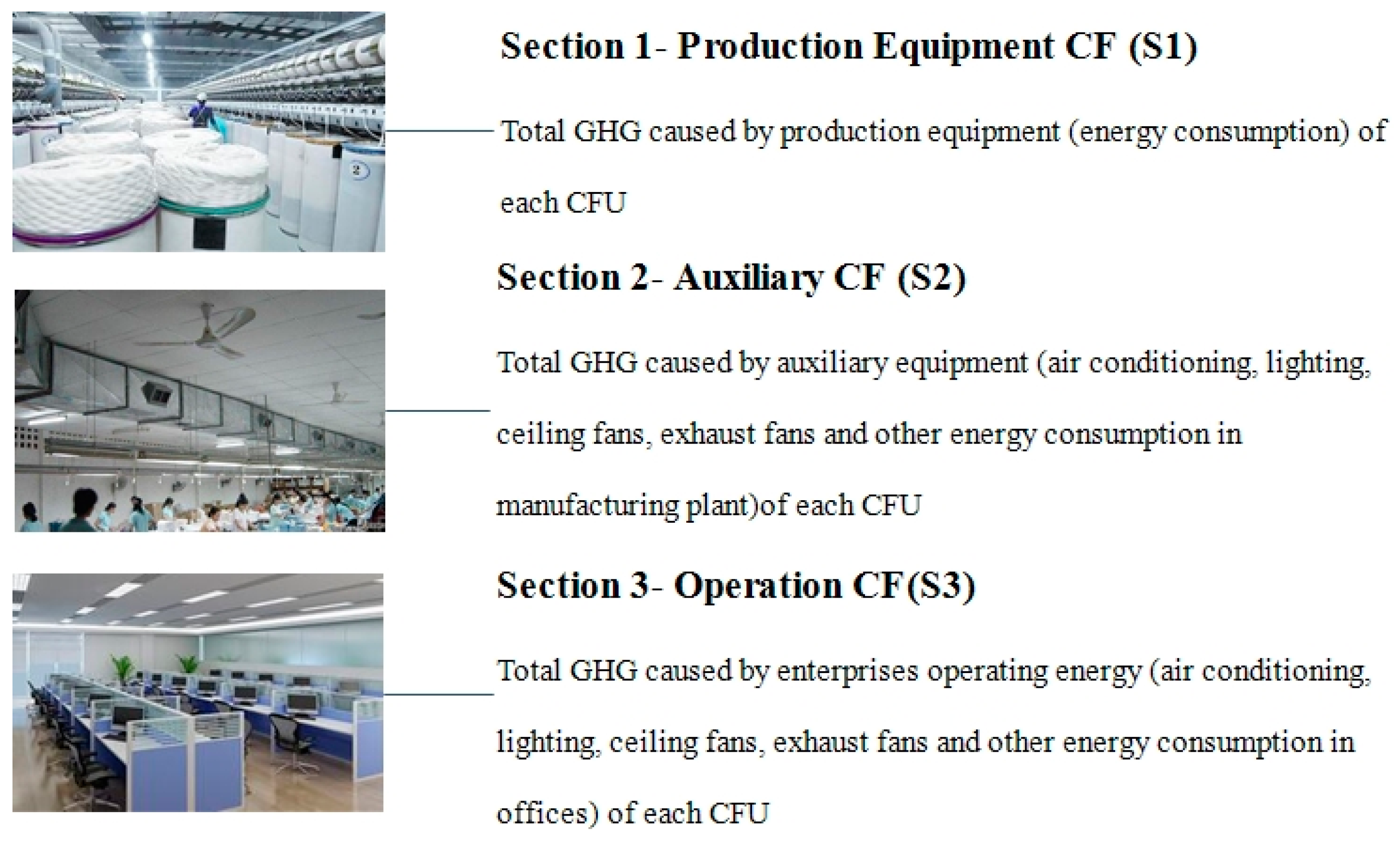
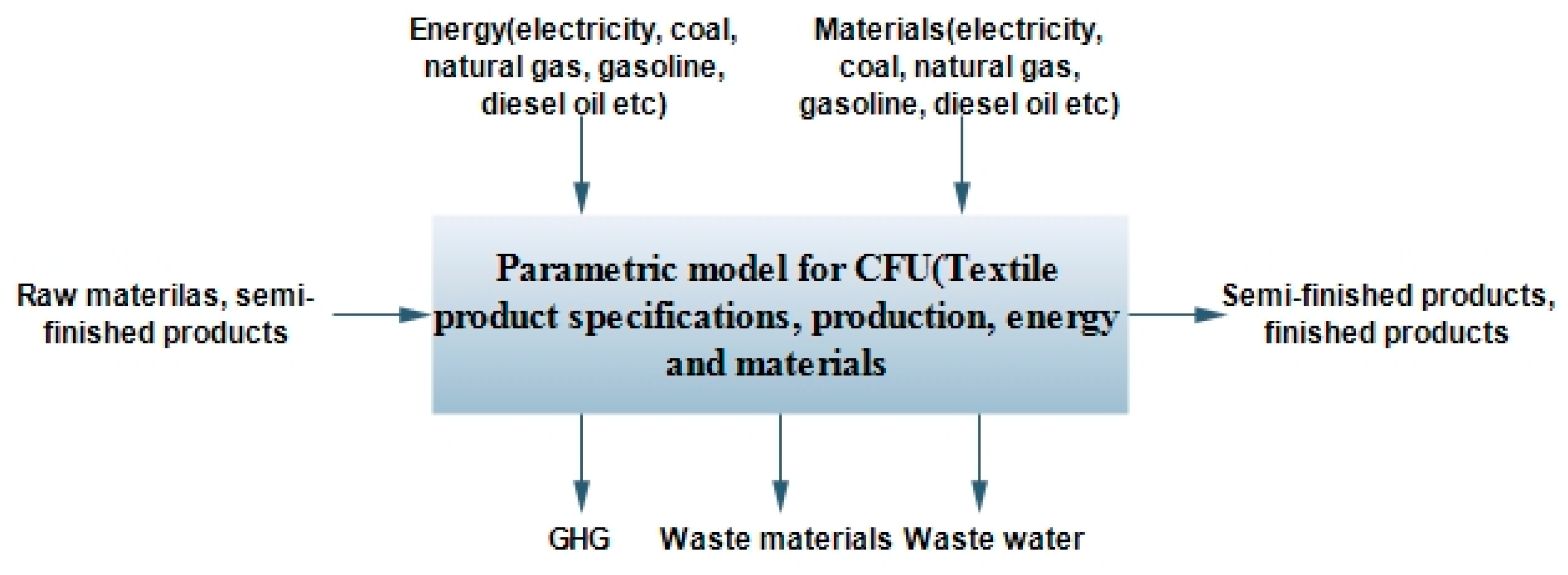
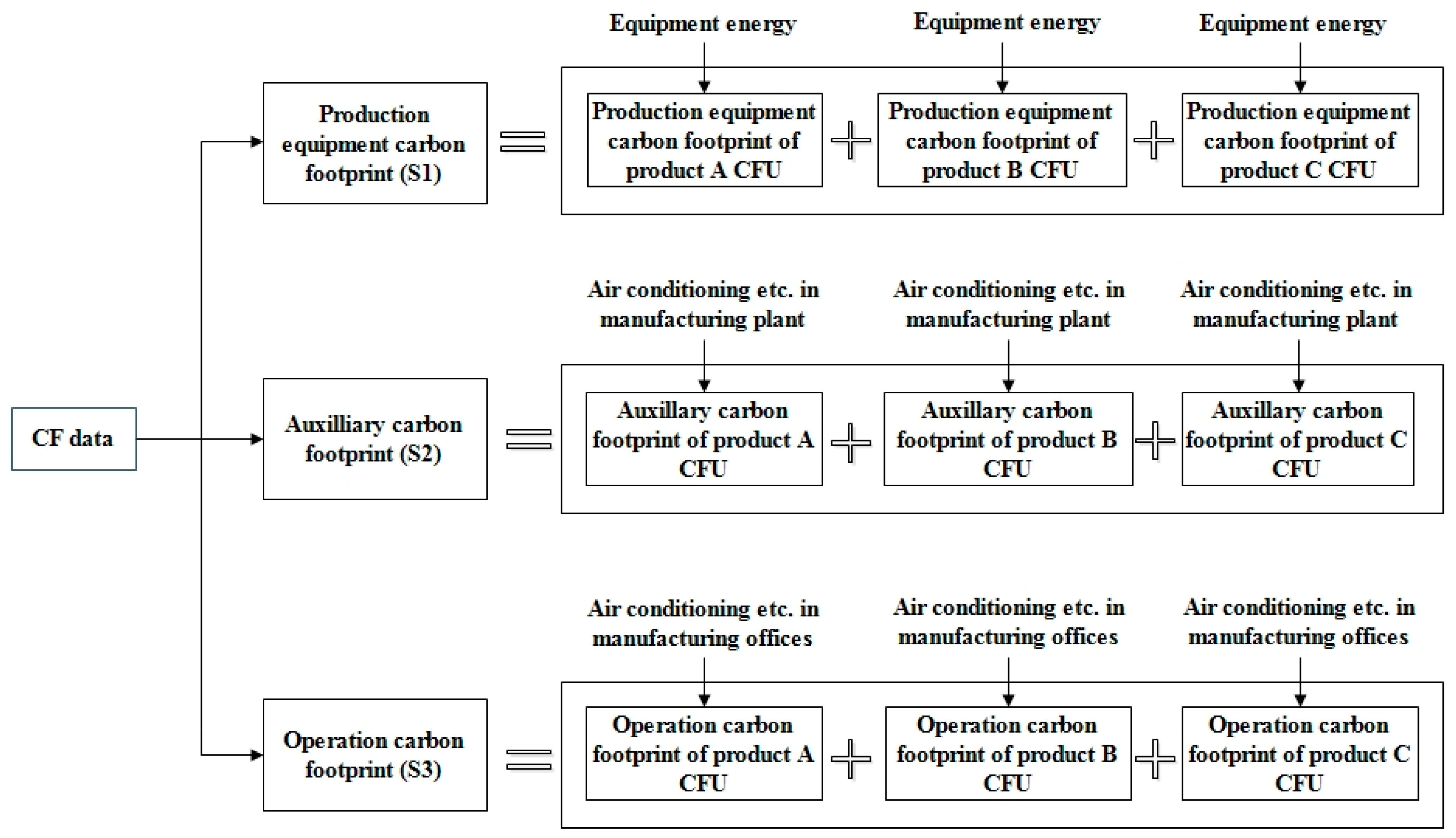
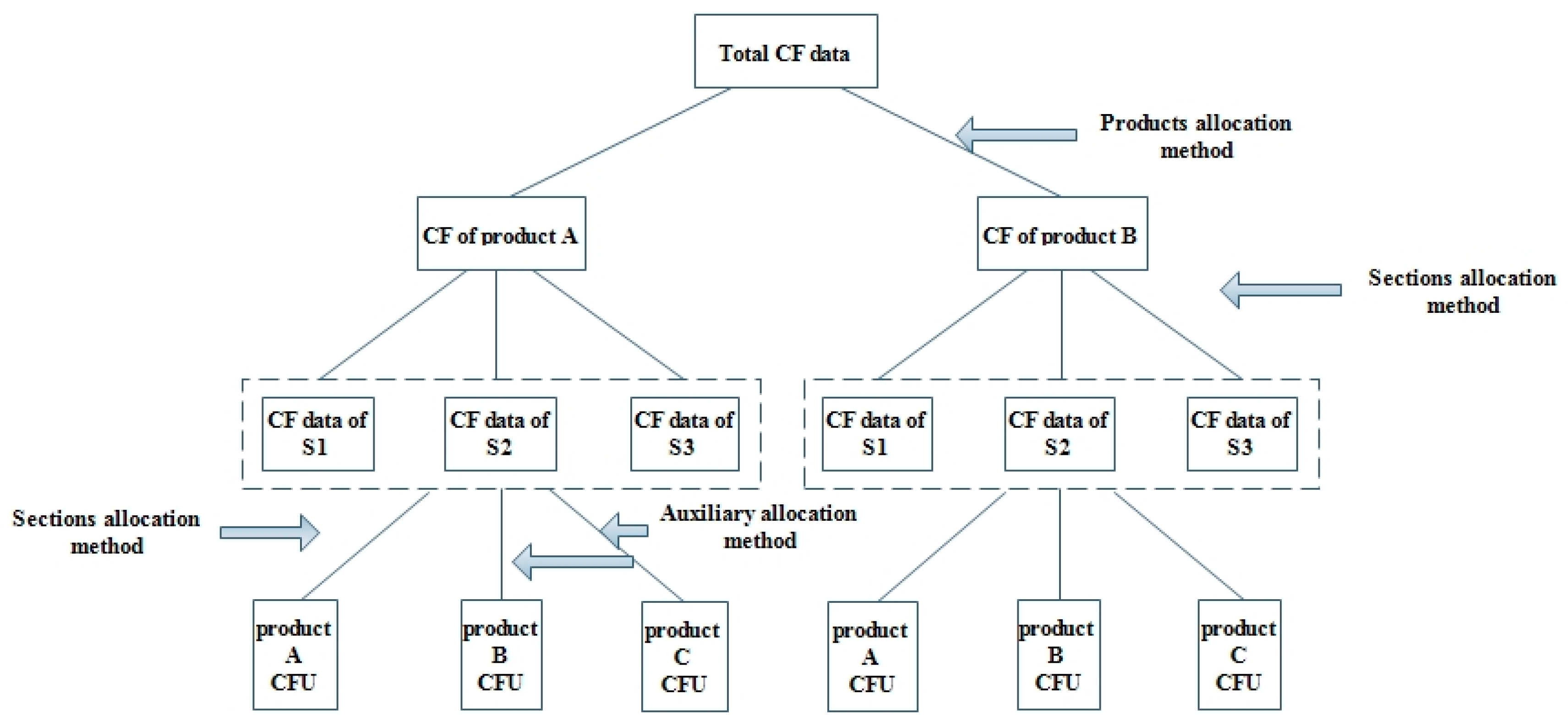
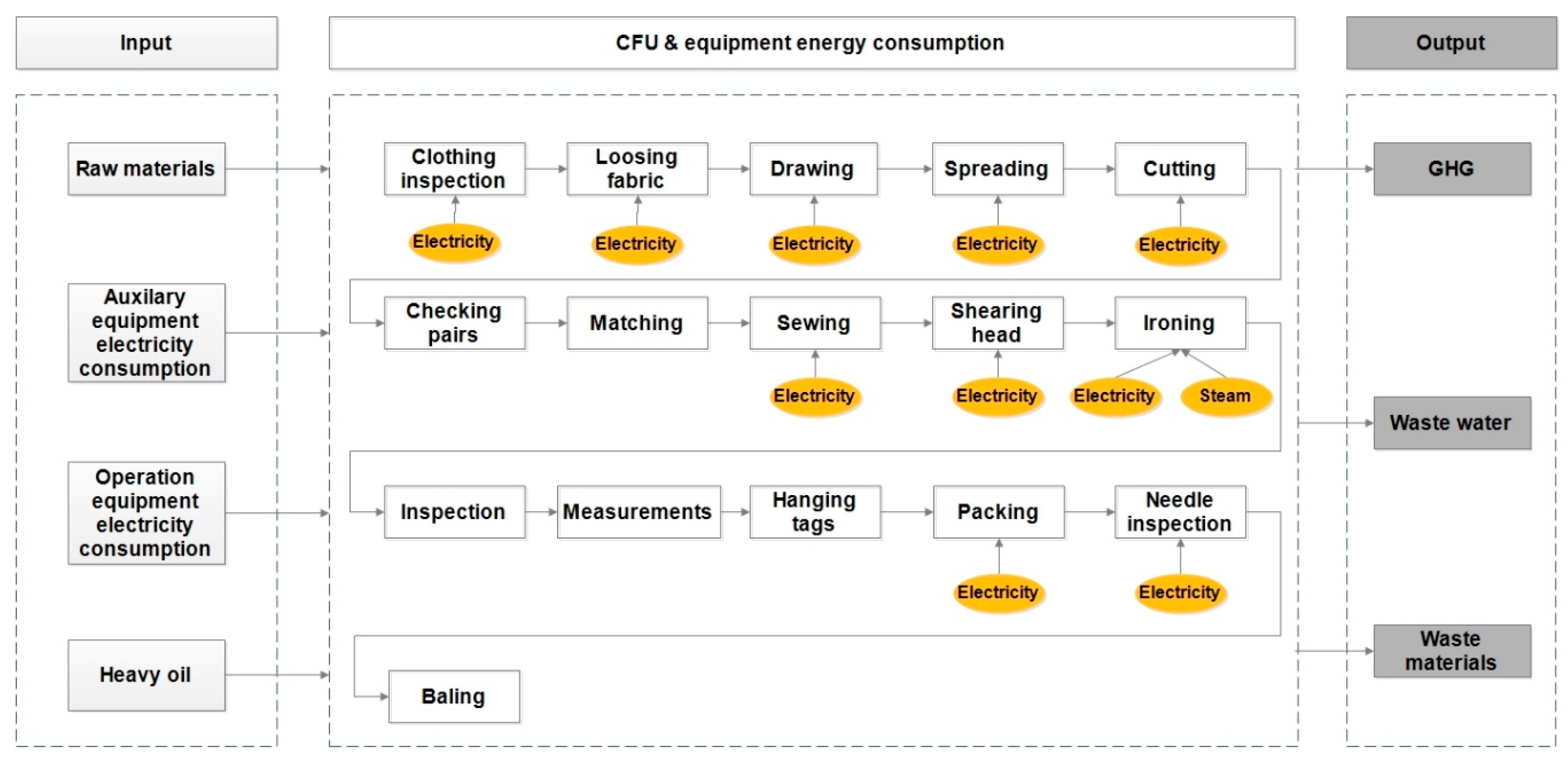
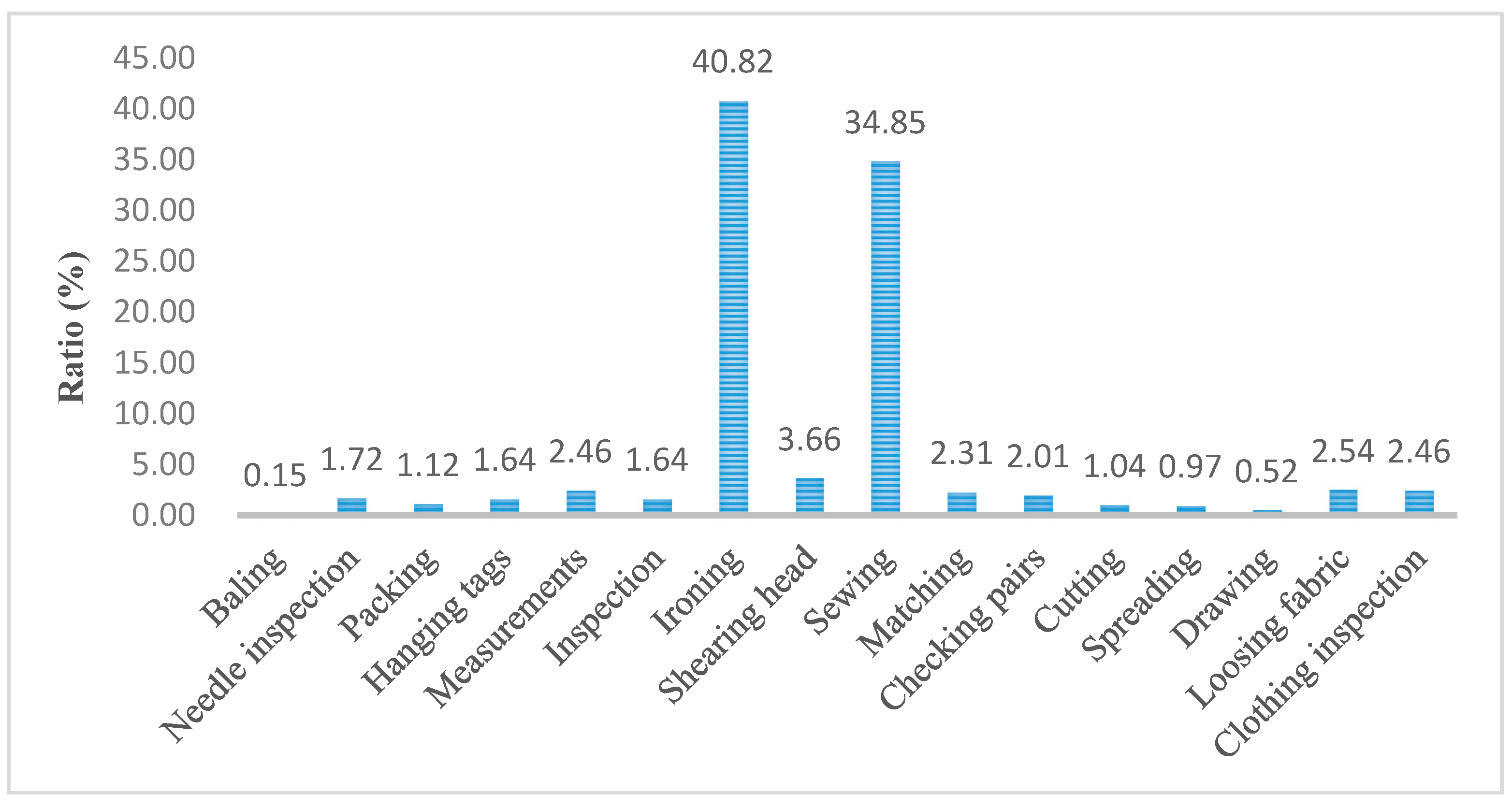
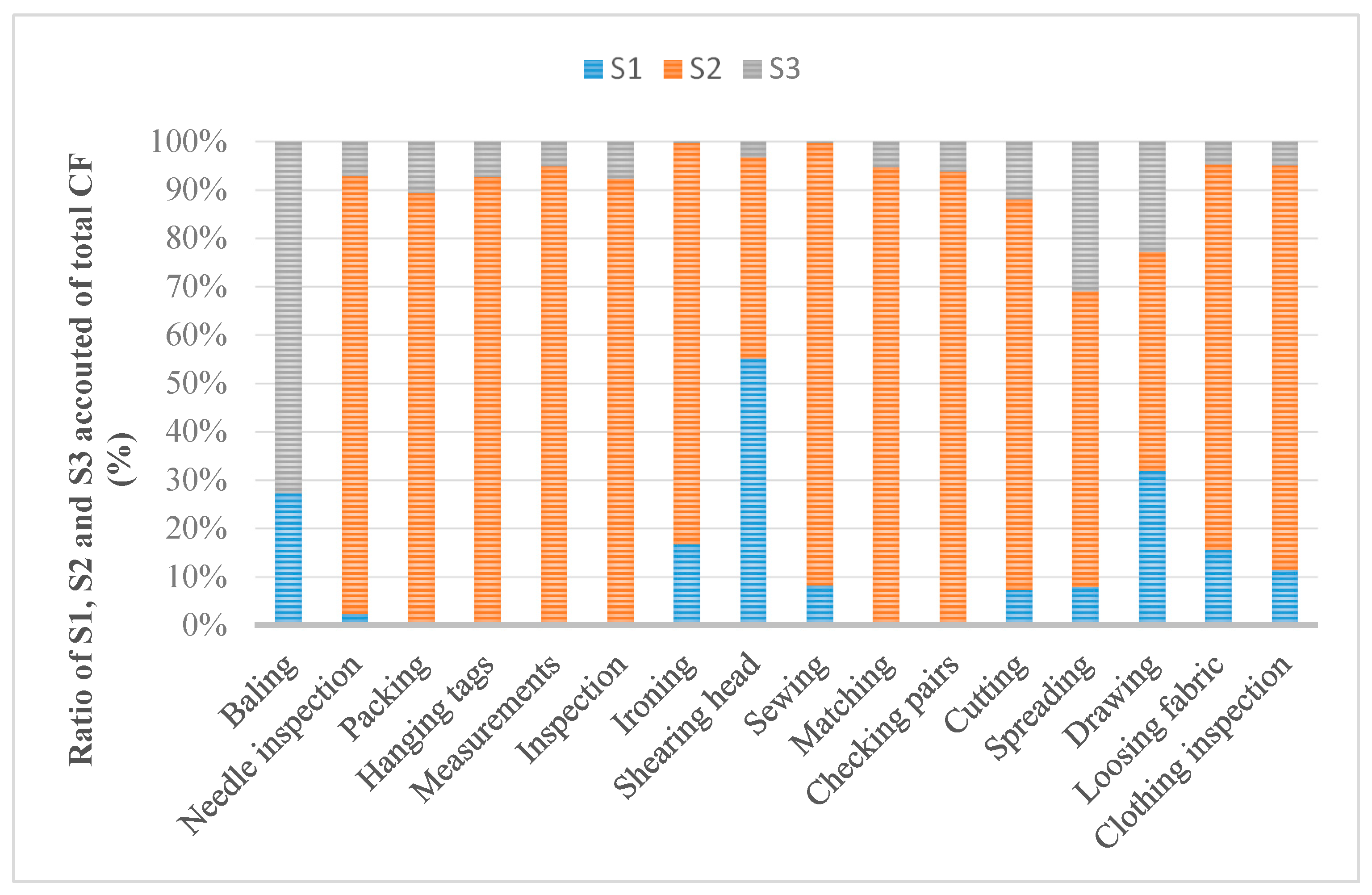
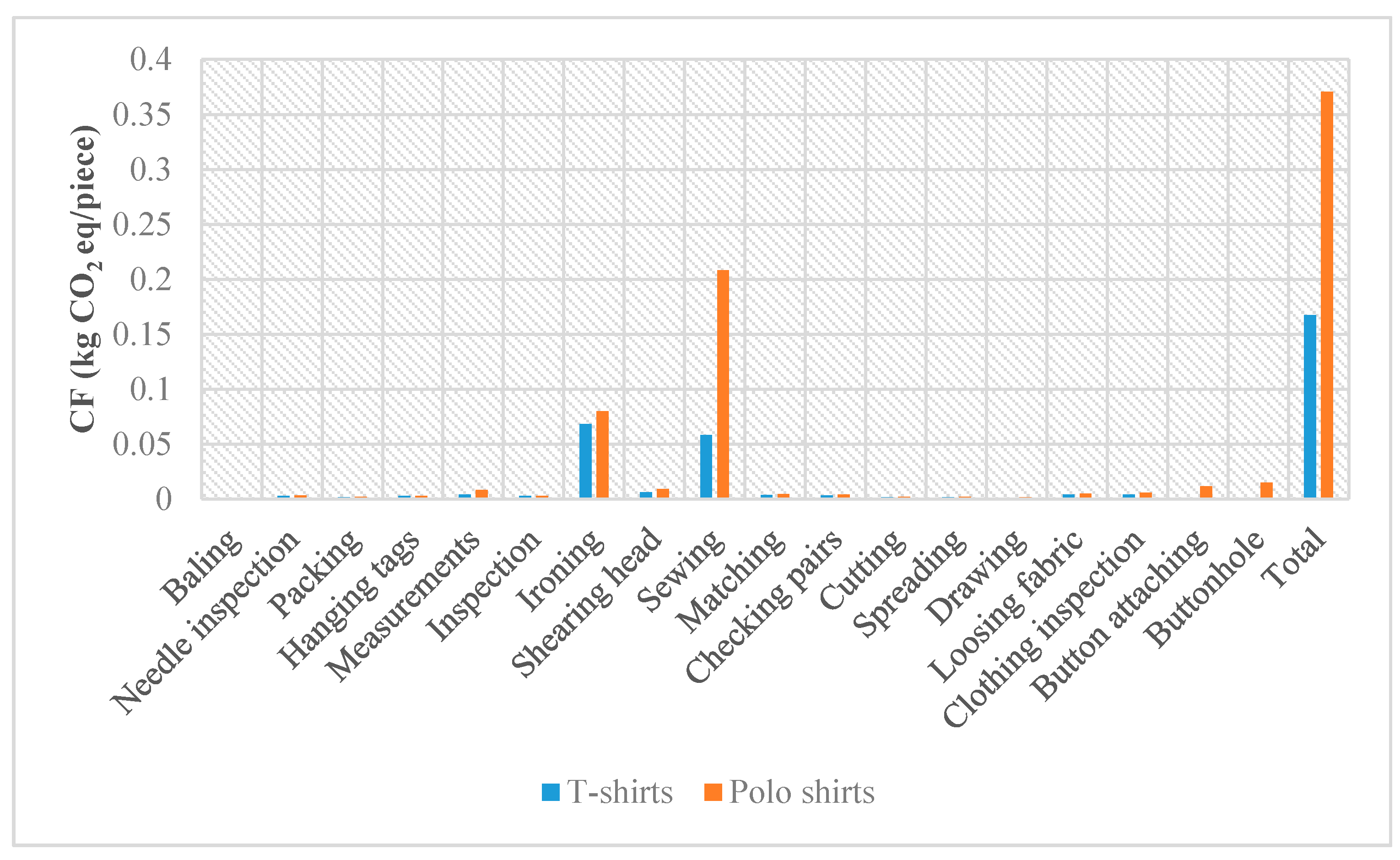
| Electricity (Purchased) | Heavy Oil | 93# Gasoline | |||
|---|---|---|---|---|---|
| Production area | Office Area | Warehouse | Restroom | Production Area | Transportation |
| 1B After treatment section | 3A Quality inspection office (Conference office) | 1A Production warehouse | 1B Restroom | 1B After treatment section | Vehicles |
| 2B Sewing section | Management office | 2A Material warehouse | 2B Restroom | ||
| 3A Sewing section | 3A Restroom | ||||
| 3B Cutting section | |||||
| Types | Pearson Correlation Coefficient | |
|---|---|---|
| T shirts/kg | Pearson Correlation | −0.868 |
| Sig. | 0.000 | |
| All types of production/kg | Pearson Correlation | −0.963 |
| Sig. | 0.000 |
© 2019 by the authors. Licensee MDPI, Basel, Switzerland. This article is an open access article distributed under the terms and conditions of the Creative Commons Attribution (CC BY) license (http://creativecommons.org/licenses/by/4.0/).
Share and Cite
Li, X.; Chen, L.; Ding, X. Allocation Methodology of Process-Level Carbon Footprint Calculation in Textile and Apparel Products. Sustainability 2019, 11, 4471. https://doi.org/10.3390/su11164471
Li X, Chen L, Ding X. Allocation Methodology of Process-Level Carbon Footprint Calculation in Textile and Apparel Products. Sustainability. 2019; 11(16):4471. https://doi.org/10.3390/su11164471
Chicago/Turabian StyleLi, Xin, Lizhu Chen, and Xuemei Ding. 2019. "Allocation Methodology of Process-Level Carbon Footprint Calculation in Textile and Apparel Products" Sustainability 11, no. 16: 4471. https://doi.org/10.3390/su11164471
APA StyleLi, X., Chen, L., & Ding, X. (2019). Allocation Methodology of Process-Level Carbon Footprint Calculation in Textile and Apparel Products. Sustainability, 11(16), 4471. https://doi.org/10.3390/su11164471




